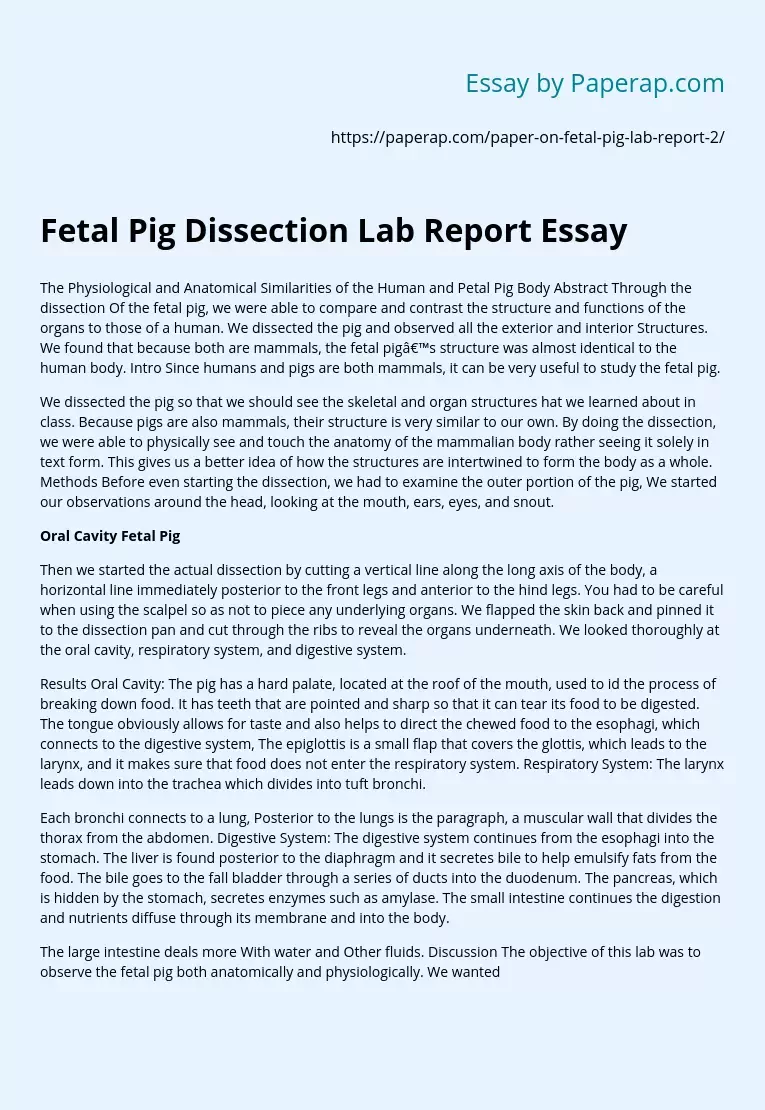Fetal Pig Dissection Lab Report Essay
The Physiological and Anatomical Similarities of the Human and Petal Pig Body Abstract Through the dissection Of the fetal pig, we were able to compare and contrast the structure and functions of the organs to those of a human. We dissected the pig and observed all the exterior and interior Structures. We found that because both are mammals, the fetal pig’s structure was almost identical to the human body. Intro Since humans and pigs are both mammals, it can be very useful to study the fetal pig.
We dissected the pig so that we should see the skeletal and organ structures hat we learned about in class. Because pigs are also mammals, their structure is very similar to our own. By doing the dissection, we were able to physically see and touch the anatomy of the mammalian body rather seeing it solely in text form. This gives us a better idea of how the structures are intertwined to form the body as a whole.
Methods Before even starting the dissection, we had to examine the outer portion of the pig, We started our observations around the head, looking at the mouth, ears, eyes, and snout.
Oral Cavity Fetal Pig
Then we started the actual dissection by cutting a vertical line along the long axis of the body, a horizontal line immediately posterior to the front legs and anterior to the hind legs. You had to be careful when using the scalpel so as not to piece any underlying organs. We flapped the skin back and pinned it to the dissection pan and cut through the ribs to reveal the organs underneath.
We looked thoroughly at the oral cavity, respiratory system, and digestive system.
Results Oral Cavity: The pig has a hard palate, located at the roof of the mouth, used to id the process of breaking down food. It has teeth that are pointed and sharp so that it can tear its food to be digested. The tongue obviously allows for taste and also helps to direct the chewed food to the esophagi, which connects to the digestive system, The epiglottis is a small flap that covers the glottis, which leads to the larynx, and it makes sure that food does not enter the respiratory system. Respiratory System: The larynx leads down into the trachea which divides into tuft bronchi.
Each bronchi connects to a lung, Posterior to the lungs is the paragraph, a muscular wall that divides the thorax from the abdomen. Digestive System: The digestive system continues from the esophagi into the stomach. The liver is found posterior to the diaphragm and it secretes bile to help emulsify fats from the food. The bile goes to the fall bladder through a series of ducts into the duodenum. The pancreas, which is hidden by the stomach, secretes enzymes such as amylase. The small intestine continues the digestion and nutrients diffuse through its membrane and into the body.
The large intestine deals more With water and Other fluids. Discussion The objective of this lab was to observe the fetal pig both anatomically and physiologically. We wanted to compare and contrast what we know about the human body with the observations seen in the dissection. We also wanted to reinforce the teachings we learned in class. After dissecting the pig, we noticed that most everything in the pig is also in the human body, Dissecting the fetal pig gave us a hands-on experience of how the mammalian body works and also a view of its structure.
The only significant difference that we could find was that the pig did not have an appendix like a human does. Instead, they only have the scum. In the pig, the scum provides the same benefits as the human appendix, found this interesting because many people used to say that the appendix was essentially a useless part of the body. After dissecting the pig, it is easy to see why people would have thought that. Since the pig is fully functional without an appendix, it would be interesting to research further how humans developed one and why it is necessary to our body.
Fetal Pig Dissection Lab Report Essay. (2019, Dec 05). Retrieved from https://paperap.com/paper-on-fetal-pig-lab-report-2/

